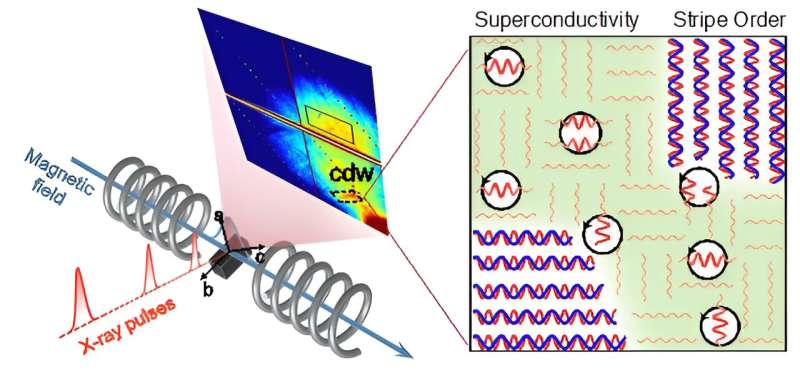This article has been reviewed according to Science X's editorial process and policies. Editors have highlighted the following attributes while ensuring the content's credibility:
fact-checked
peer-reviewed publication
trusted source
proofread
What makes high temperature superconductivity possible? Researchers get closer to a unified theory

In copper-containing materials called cuprates, superconductivity competes with two properties called magnetic spin and electric charge density wave (CDW) order. These properties reveal different parts of the electrons in the superconductor. Each electron possesses spin and charge.
In a regular metal, the spins cancel each other out and electrical charges are uniform across a material. However, the strong electron–electron interactions in high-temperature superconductors such as cuprates give rise to other possible states.
New research published in Nature Communications has examined materials where strong magnetic interaction causes some of the electron spins to order along stripes. This occurs when spin density waves (SDW) and CDWs lock together to form a stable long-range "stripe state" where the peaks and valleys of the two waves are aligned.
This state reinforces the stability of the SDW and CDW. This stripe state competes with and interrupts the superconducting phase. Now, however, researchers have found that short-range CDW can be compatible, rather than competitive, with superconductivity in cuprate materials. This finding runs counter to scientific conventional wisdom.
As expected, short-range CDW competes with long-range stripes to suppress superconductivity. Unexpectedly, CDW also coexists with and is enhanced by short-range superconductivity.
The research also identified the possibility that short-range charge order may enable the formation and motion of vortices in the superconducting phase. This means researchers may be able to stabilize superconductivity at higher temperatures and magnetic fields by controlling or enhancing short-range charge order.
The results also provide important insight into the development of a unified quantum description of superconductivity in the cuprates.
The research was performed using X-ray measurements in a previously uncharted high magnetic field regime of the cuprate La1.885Sr0.115CuO4.
The CDW order consists of two components marked by distinct magnetic field and temperature dependencies.
The sample spontaneously segregates into superconducting and, alternatively, spin–charge stripe ordered regions, clarifying how long-range spin order and bulk superconductivity coexist.
More interestingly, the static vortex state observed at low fields can be made fluid—a vortex liquid state—in high fields ranging from 12 to 24 Tesla.
At these fields, the long-range superconducting phase is suppressed by field-induced mobile vortices. Surprisingly, a sudden enhancement to the CDW intensity is commensurate with the vortex melting field—a field much smaller than the upper critical field that quenches superconductivity.
This research supports the phase-disordering scenario for the superconducting transition, motivating a unified quantum description of density waves and superconductivity in cuprate superconductors.
More information: J.-J. Wen et al, Enhanced charge density wave with mobile superconducting vortices in La1.885Sr0.115CuO4, Nature Communications (2023). DOI: 10.1038/s41467-023-36203-x
Journal information: Nature Communications
Provided by US Department of Energy



















